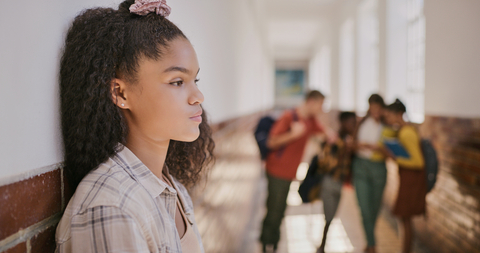
LOS ANGELES– Bullying in high school is up since the pandemic, with more students saying they have been bullied at school. And more than 40 percent of bullied students said the incidents took place in hallways, stairwells and classrooms.1
“There are so many opportunities for kids to bully others in traditional school settings,” said Shellie Hanes, superintendent of Learn4Life, a network of 80+ public high schools. “The same students are together all day, every day, sometimes without adult supervision. It can be a breeding ground for bullies.”
Learn4Life offers a university-type model, with flexible schedules and one-on-one instruction and so students can come in on different days and times, which is ideal for those who need to work or take care of young children, and it virtually eliminates opportunities for bullying.
Hanes said that many of its 53,000 students transferred to Learn4Life to escape bullying. One student, Valerie G., was bullied from day one of high school and when the staff didn’t offer her support from the bullies, she gave up and began failing her classes.
“On my first day at Learn4Life I was ready to be judged – it was my defense mechanism,” said Valerie. “But instead, I was greeted by staff who didn’t care about my past or judge me because of my brown skin, or the way I looked or my previous school record. All they wanted to do was help me get back on track and find a new lifestyle for myself.”
Today Valerie is flourishing, taking dual enrollment classes at a community college and plans to go to college and medical school to become a surgeon.
October is Bullying Prevention Month, designed to educate parents about bullying’s negative effects on the physical, social, emotional, academic and mental health of their child that may persist into adulthood. Students who are bullied often do worse in school. They are less engaged, and their learning suffers. When bullied or left out, teens are more likely to take future social rejections much more personally, believing that there is something wrong with them. Bullied teens are less resilient and take longer to bounce back from rejection than teens who feel accepted by their peers.
When it comes to school safety, bullying is teachers’ top concern, even more so than school shootings or drugs on campus, according to a recent report from the RAND Corporation.2 And it is a key concern for parents, too. A Pew Research Center survey of parents conducted in the fall of 2022 found that nearly three-quarters of parents said they were very or somewhat concerned about their child being bullied.3
“We have a strict policy against bullying, and more importantly, we’ve eliminated the structure where bullies thrive,” Hanes said. “Plus, we teach students coping and resiliency skills, which help them deal with life’s ups and downs, and restorative justice to teach young people the effects their actions have on other people.”
References:

